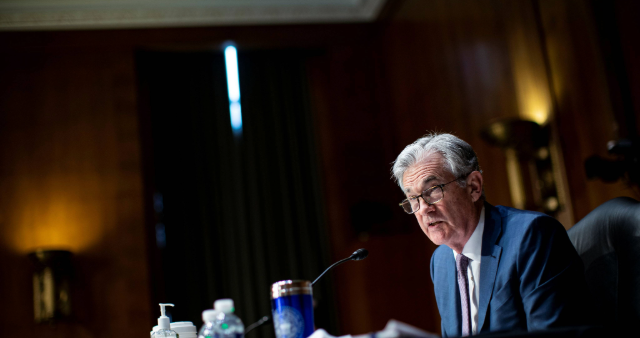In just four meetings, the ECB cut interest rates four times – because inflation is losing steam. This would be the new normal, were it not for the risks posed by an unpredictable US trade policy.
In what has become almost habitual fashion, the European Central Bank (ECB) has trimmed its deposit rate by another 25 basis points to 2.0 per cent in its fourth interest-rate decision of the year.
“This means that key interest rates have reached a level that can certainly no longer be described as restrictive,” says Joachim Nagel, President of the Deutsche Bundesbank. What are we to make of this new interest-rate level?
Hardly any doubt ...
The renewed interest-rate step is essentially justified by two factors. On the one hand, there is growing confidence that the long-simmering upside risks to inflation have been successfully overcome. Central bankers are drawing confidence from the successes already achieved in combating inflation. In May, eurozone inflation – at 1.9 per cent – was already at the two per cent target level, although it was recently cushioned by a decline in volatile energy prices.
Looking ahead, there is little doubt that the inflation target will be achieved. In particular, a decline in wage inflation should have a supportive effect. For example, the ECB's wage development indicator for the eurozone (excluding one-off payments) signals that wages are expected to rise by 3.0 per cent in the fourth quarter of 2025, following 4.7 per cent in the last quarter of last year.
… but many question marks
At the same time, there are still question marks over the short-term economic outlook for the eurozone. As expected, the ECB Governing Council is concerned about the “drivers of uncertainty”, as Nagel recently put it. Particular focus is being placed on the back-and-forth in trade policy. Even with a straightforward trade policy, it is only possible to make rough predictions about the economic impact of changes in the customs regime. In a highly unpredictable cycle – in which tariffs are threatened, come into force, are then partially withdrawn, only to be threatened again – the predictive power of any forecasts is further reduced.
The only thing that seems certain in this context is that US tariff policy will have a negative impact on economic development in the eurozone. On the one hand, higher tariffs weaken the competitiveness of European goods on the US market. On the other, the high level of uncertainty makes longer-term planning more difficult, which is likely to cause companies (worldwide) to postpone their investment decisions. As a result, there are understandable arguments for somewhat weaker economic growth in the eurozone. And since weaker economic momentum tends to dampen prices, this entails certain downside risks for inflation rates.
New ECB projections
The staff of the Eurosystem ‘translate’ this complex situation into their latest macroeconomic projections as follows:
- They still see the inflation target of two per cent as within reach. For 2025, they expect average overall inflation in the eurozone to be 2.0 per cent, while average inflation excluding energy and food is expected to be 2.4 per cent.
- The short-term growth outlook remains modest. As in their March projections, economists are forecasting real growth of 0.9 per cent for this year. The unchanged growth projection for 2025, despite an unexpectedly strong first quarter, means that the ECB expects the outlook for the rest of the year to be somewhat weaker.
Where will the “interest-rate slide” end?
Four interest-rate cuts this year, out of a total of eight since the start of the current cycle of rate cuts in June 2024, are already having an impact. How far can interest rates fall now?
In an interview with the Frankfurter Allgemeine Zeitung, ECB Chief Economist Philip Lane provided some initial indications. He divided monetary policy into three zones: a clearly restrictive zone with interest rates in the high two per cent range or above, a clearly accommodative zone with interest rates below 1.5 per cent, and a zone in between, which is the focus of the ECB's current discussions. In his view, further interest-rate cuts into the accommodative zone would only be justified “if there were more substantial downside risks to inflation or a more significant slowdown in the economy”. He does not see either of these factors at present.
Subject to a further deterioration in the inflation and economic outlook, Lane has thus severely limited the scope for further interest-rate cuts. Under “normal” conditions, a maximum of two further interest-rate cuts of 0.25 percentage points to a key interest rate of 1.5 per cent would therefore be expected. As a result, upcoming discussions by the ECB Governing Council are likely to focus increasingly on the possibility of interest-rate pauses.
Back to normal range
In response to the financial and euro crisis, the ECB pursued a zero and negative interest-rate policy for more than 10 years until the summer of 2022, which probably exceeded by a wide margin the imagination of many market observers at the time.
This exceptionally expansionary period of monetary policy in the still young history of the euro area was then followed, from July 2022, by a determined fight against inflation rates that at times reached double digits. Within 14 months, key interest rates were raised by 4.5 percentage points before being lowered again from June 2024. After being “expansionary” and “restrictive”, monetary policy in the eurozone is now back in the “normal” range for the first time.
Remain flexible
The hope is that the eurozone's monetary policymakers will remain there for a while longer. Lane, for example, draws confidence from the normalisation of wage inflation. He sees the current low unemployment rate and existing labour shortages as a framework in which companies and employees are likely to continue to adjust to wage increases in the future. As a result, he considers wage inflation of three per cent on average in the eurozone to be conceivable, after it has mostly been just over one to two per cent in the past decade. Taking into account rising labour productivity, the wage growth expected in the medium term could therefore make the two per cent target more credible and a stay in the normal monetary policy range more likely.
However, in a world with erratic US trade policy, inflation and economic forecasts remain an extremely thankless task. The same applies to statements on the future direction of monetary policy. Appropriate monetary policy must continue to respond flexibly to challenges in the future.
LEGAL NOTICE
One of the purposes of this publication is to serve as advertising material.
The information contained and opinions expressed in this publication reflect the views of Flossbach von Storch at the time of publication and are subject to change without prior notice. Forward-looking statements reflect the judgement and future expectations of Flossbach von Storch. Actual performance and results may, however, differ materially from such expectations. All information has been compiled with care. However, no guarantee is given as to the accuracy and completeness of information and no liability is accepted. The value of any investment can fall as well as rise and you may not get back the amount you invested
This publication does not constitute an offer to sell, purchase or subscribe to securities or other assets. The information and estimates contained herein do not constitute investment, legal and/or tax advice or any other form of recommendation. In particular, this information is not a replacement for suitable investor and product-related advice and, if required, advice from legal and/or tax advisers.
This publication is subject to copyright, trademark and intellectual property rights. The reproduction, distribution, making available for retrieval, or making available online (transfer to other websites) of the publication in whole or in part, in modified or unmodified form is only permitted with the prior written consent of Flossbach von Storch.
Past performance is not a reliable indicator of future performance.
© 2025 Flossbach von Storch. Alle Rechte vorbehalten.




